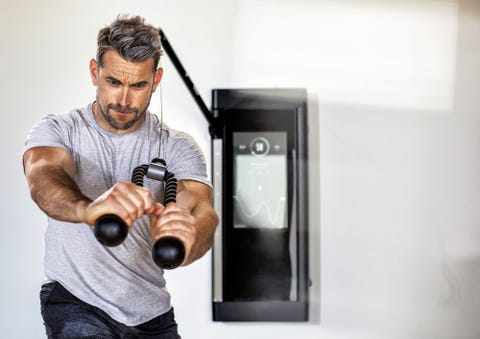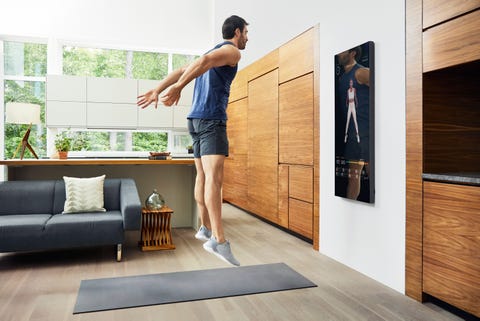I’ve done exactly three reps each of four different exercises—shoulder presses, pulldowns, bench presses, and deadlifts—but the artificial intelligence in this Tonal unit, a cable-based system with a video screen mounted to a wall like a TV rotated vertically, thinks it has me all figured out. It thinks I should bench 63 pounds of resistance per arm next.
WTF? I typically bench 90-pound dumbbells, so as I position myself in the Tonal unit for a 63-pound bench press, I’m all set to exact some revenge. I brace my torso, plant my feet, press upward, and the weight moves . . . just like 90 pounds would have.
I hadn’t accounted for Tonal’s electromagnetic resistance feeling different than that of traditional weights. Tonal’s AI did. The future of home fitness doesn’t simply give you a workout; for $3,000, it provides you with equipment, spots you, motivates you, and pushes you. And it keeps you guessing. As people build out their own personal workout spaces, that type of compact efficiency is an attractive concept.
Home Gyms Are Getting Smarter
The flagship product of a three-year-old San Francisco startup of the same name, Tonal is the most publicized entry in the “smart gym” revolution and promises you a quality home workout with expert instruction—all without turning your living room into a Marriott fitness center.
After watching the rise of Peloton, which went from unknown connected-stationary-bike company in 2012 to a $4 billion valuation in August, Silicon Valley is all in on home fitness. Tonal and another startup, the Manhattan-based Mirror, represent a wave of devices that want to bring big-box fitness home, so you can do preacher curls right before you hit the dinner table.

As recently as a decade ago, a home workout was a P90X DVD and a mess of dumbbells across your living-room floor. For that three grand plus $49 a month for streaming workouts, Tonal cleans up the mess. It’s a slim, 22-by-51-inch unit that attaches to your wall, an LED touchscreen in its center, two adjustable cable arms hidden behind it. When it’s training time, you pull out the arms and the screen lights up, displaying a Netflix-like collection of workouts. These range from exercises to improve your distance-running performance (Run Faster, Run Further) to HIIT sessions (HIIT It Hard) to muscle-building circuits.
You can also select Free Lift, transforming Tonal into the kind of cable machine you’d find in just about any gym. Its AI doesn’t guide you in this mode, but the device still tracks your motion, delivering feedback that gym experts will appreciate. Fresh off that bench press, I enter this mode, getting more of a feel for Tonal’s resistance and its advanced “smarts.” I do reps of shoulder presses, enjoying the smooth resistance and watching the screen. After each rep, a bar chart appears. The machine is tracking my reps and showing my power output in each one.
The unit’s handles have gyroscopes to track range of motion, and its internal sensors measure power output. Tonal can collect and store this data along with other basic info (your favorite workouts, your typical resistance, the reps you complete), eventually feeding the data through its AI algorithm in order to optimize resistance. The goal is to be more than a smart gym; Tonal could be a smart training assistant. Its workouts are designed by the company’s training staff, but its AI helps you choose the right weights and directs you toward workouts that suit your goals and preferences. A Tonal unit could someday determine better exercises for you based on such things as height, age, even motivation, but the company doesn’t have a timetable for this.
Shifting to New Forms of Resistance
For now, Tonal’s ability to mimic various resistance-training strategies is its selling point. Its electromagnetic resistance can be altered in an instant, and its programming allows it to simulate more than merely lifting weights. You can use advanced techniques that normally require extra equipment—for example, curling as if you had chains attached to your weights (with the resistance progressively increasing as you lift)—or even employ eccentric loading techniques, with the resistance increasing as you lower the weight.
I bang out a set of lat pulldowns, then a set of biceps curls with simulated chain resistance, and start getting a solid burn. Next I experiment with more bench presses, this time using the unit’s automated spotter system to push out a few extra reps. This doesn’t feel quite right; essentially, the “spot” is a programmed weight reduction that I can’t change. I tell Tonal’s representatives that a human spotter would force me to keep working for my rep. They mention that issues like this can be fixed quickly with a software update. “You can wake up one morning,” says David Azaria, Tonal’s head of software, “and just find new functionality.”

Tonal
Because the hardware is modeled after a cable machine, it’s ideal for muscle-building exercises like curls and shoulder presses, but not cleans, snatches, and other functional movements that have grown so popular.
Over the past two years, trainers have started favoring total-body moves; even budget-priced big-box gyms like Blink Fitness now have battle ropes and medicine balls. Tonal’s movement tracking and resistance may seem right out of The Jetsons, but to forward-thinking trainers it’s Flintstonian. “In the fitness world, we are clearly going away from machines,” says Mike Boyle, a veteran Boston-based trainer. “You can get an awful lot of stuff done with dumbbells and a bench.”
Tonal founder and CEO Aly Orady counters that I can find other ways to perform the moves that the unit doesn’t accommodate. No power cleans? I can tweak my workouts to do deadlifts and jump squats. But given its price tag, should I need to do that?
Fitter Reflection
At a glance, the Mirror looks a lot like Tonal: another wall-mounted unit for the home-fitness future, minus the cable arms. But its training approach is different. Founder and CEO Brynn Putnam, a former professional dancer and veteran of the group-fitness scene, designed the Mirror ($1,495 plus a $39-a-month subscription fee) to be essentially a giant iPhone with a well-built streaming fitness app. (Think Nike Training Club or Beachbody on Demand.)
Its screen sets it apart: It’s highly reflective, so I can see my form as I’m watching an onscreen trainer. Using the Mirror’s app, I select a workout on my iPhone, sync my Apple Watch, and I’m greeted by Gerren Liles, my video trainer, who’s going to put me through a high-intensity interval workout.

It’s Peloton for biceps. My heart rate, measured via my Apple Watch, is displayed in the bottom left corner, along with a list of other users doing this same workout. A few minutes later, I’m in first place on the leaderboard—and soaked in sweat. “The quality of an iPhone workout isn’t great,” says Putnam. “I wanted to get people more excited.” A pair of dumbbells and a bench can’t do that.
The Mirror’s workout library includes yoga, HIIT, and strength-building dumbbell routines, but Putnam doesn’t see the Mirror as simply a fitness machine. She sees it as a new platform.
“You have your TV and your phone,” she says. “We’re vying to be the next screen in your life. Fitness is our first vertical.”
The Mirror and Tonal are giving the fitness world a heads-up: Don’t be surprised if electromagnetic-resistance machines land in your gym soon. For now, expect stumbles, but know that Tonal and the Mirror are on the right track, giving us home workouts that involve way, way more than burpees and body weight.
Source: Read Full Article
